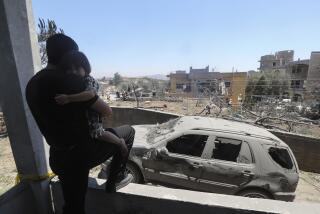Persian Gulf Lessons Fuel High-Tech Bosnia Air War
WASHINGTON — The allied air campaign now being conducted over Bosnia-Herzegovina is drawing many of its techniques from lessons learned in the 1991 Persian Gulf War, but there are important new wrinkles.
In one innovation, U.S. Air Force pilots flying over Bosnia were able to use sophisticated electronic simulators that showed them their assigned flights in “virtual-reality” images.
Also, all North Atlantic Treaty Organization pilots are benefiting from a new American-made high-speed system that provides complete intelligence “snapshots” of their target areas before the next air strike is launched.
The procedure, known as the Contingency Air Reconnaissance System, catalogues information from satellites, spy planes, sensors and radio intercepts and feeds it back to air commanders within two hours.
One of the military’s biggest complaints in the Gulf War was that intelligence too often was never passed on to those in the field. The contingency system does not totally solve that problem, but it does help significantly in ensuring that pilots are kept up to date.
Here is how the system works:
* Allied air commanders launch their initial strike, hoping to destroy enemy antiaircraft missile sites, radar installations, communications facilities and command centers.
* As soon as warplanes have returned to base, intelligence analysts start piecing together information on the outcome of the initial strike from satellites, reconnaissance flights and radio interceptions and putting them into usable form for pilots.
* Pilots preparing to fly with the next wave of warplanes are given detailed information about which targets have been destroyed and which are intact.
The procedure gives air commanders an advantage on two fronts: It lets them avoid bombing targets that already have been destroyed, and it alerts pilots about sites that still pose a danger.
The Air Force maintains a special intelligence “cell” at the NATO air base at Vicenza, Italy, to process information and feed it back to air commanders.
The new training simulators also are a recent development. Pilots sit in a realistic cockpit and watch images of the Bosnian countryside flash by as it would appear with each change they make at the controls.
The simulators can even show pilots what they would see if there was bad weather on the day of a mission. They also can simulate incoming missiles and other such dangers.
More to Read
Sign up for Essential California
The most important California stories and recommendations in your inbox every morning.
You may occasionally receive promotional content from the Los Angeles Times.










